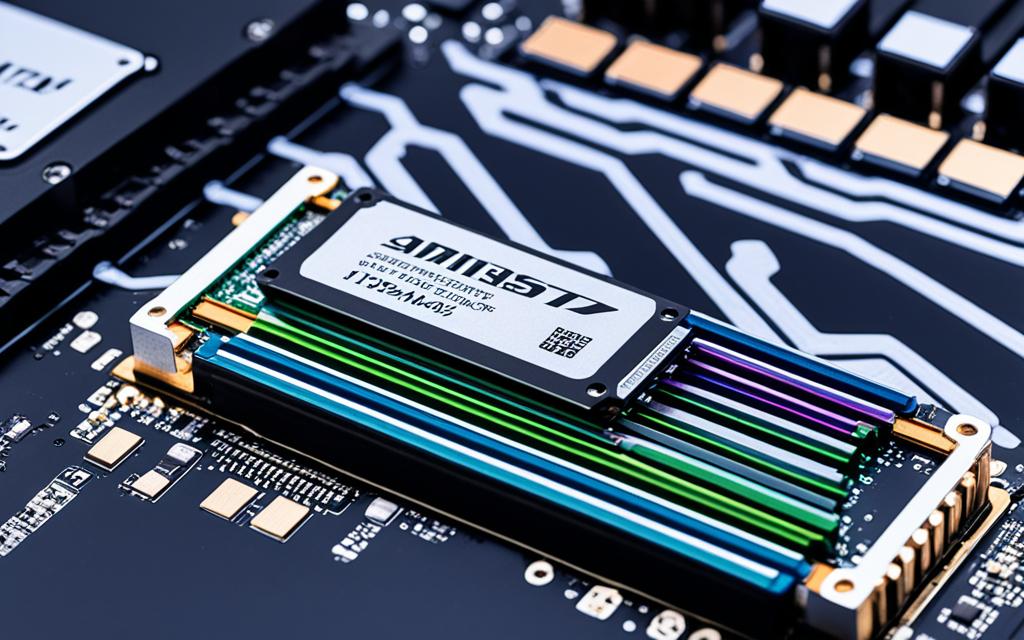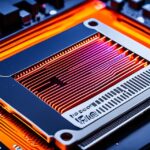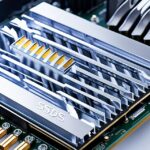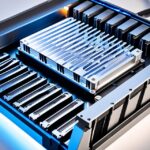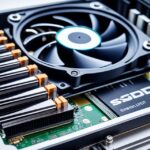Table of Contents
As more people look for high-speed storage, keeping M.2 SSDs cool matters more. The need for a heatsink on M.2 SSDs can be missed sometimes. But, to keep them running fast and lasting long, cooling is key. When pushing these drives hard, it’s critical to know if a heatsink is needed.
The sweet spot for running M.2 SSDs is between 30°C and 65°C. Yet, in heavy use, NVMe SSDs can go past 80°C. Being over 65°C often may mean your computer needs better airflow. You might have to add fans or an NVMe heatsink. This is vital to stop slowdowns, data loss, or even damage12. We’ll dig into how managing SSD temperatures is important for top performance.
Key Takeaways
- M.2 SSDs typically operate within a temperature range of 30°C to 65°C.
- Heatsinks are recommended for extended read and write performance in NVMe SSDs.
- Overheating can lead to performance decreases and potential data loss.
- Crucial SSDs have an operational temperature range of 0 to 70 °C.
- Passive cooling solutions like heatsinks provide effective, noise-free performance boosts.
- Motherboards often come equipped with basic heatsinks, but effectiveness can vary.
Understanding M.2 SSDs and Their Variants
The rise of M.2 SSDs has changed how we store data. They offer a small and efficient way to meet the modern computing needs. These SSDs shine in many areas like gaming and transferring data. It’s important to know about them to choose the right one for you.
The Shape and Technology Behind M.2
M.2 modules serve many roles, including as SSDs. They can also handle Wi-Fi, Bluetooth, and GNSS3. The M.2 standard supports different interfaces, like PCIe and SATA, for various needs3. These modules have a special naming system, such as 2242 or 2280. This tells us their size in millimetres3.
SATA vs NVMe: What You Need to Know
When we compare SATA vs NVMe, NVMe offers much faster read and write speeds. SATA drives work at about 500MB/s. But, NVMe can reach speeds over 7,000MB/s with the latest tech4. This makes NVMe better for things like gaming and big data projects4.
It’s important to know if these drives will work with your computer. While many computers use SATA, M.2 is becoming more common, especially the NVMe type4. Understanding the speed and efficiency differences helps you make smart choices about SSDs. This affects your system’s overall SSD performance comparison.
Do You Need a Heatsink for M.2 SSDs?
Managing the temperature of M.2 SSDs is crucial for their best performance and life span. These SSDs, especially on PCIe 4.0 and 5.0, get very hot under heavy use. They work best between 0°C to 70°C. Going outside this range can lower performance, especially during intense tasks5. As SSD technology has improved, the importance of heatsinks for M.2 has grown. For example, PCIe 3.0 SSDs might just need a heatsink on the controller. But, PCIe 4.0 NVMe drives often require full cooling solutions6.
Temperature Management in M.2 SSDs
To get the most out of M.2 SSDs, watching their temperatures is key. Without proper cooling, they can get too hot. This heat can make the SSDs slow down. The latest Gen4 and Gen5 SSDs, like the MP600 PRO XT and MP700, make a lot of heat. They need better cooling5. It’s good to use software from the SSD maker to check temperatures. This ensures they stay within safe limits.
When a Heatsink is Required
Getting a heatsink for your M.2 SSD might be necessary, not just a choice. SSDs used for constant, large data moving can overheat. This heat can cause them to slow down, needing a heatsink6. Many Crucial SSDs stay within 0 to 70°C. Their T700 series comes with heatsinks for better performance, quietly1. Some motherboards already have cooling for M.2 SSDs. For high heat situations or when you need the best performance, an extra heatsink is key.
Factors That Affect Cooling Requirements
Various factors shape the cooling needs for M.2 SSDs, crucial for their best function. These include motherboard cooling methods, system airflow, and PCIe generation impacts.
Motherboard Cooling Solutions
Motherboards use different cooling techniques to keep SSD temperatures in check. Passive heat sinks are cheap and silent but might not cool enough during heavy use. For instance, a Gen3x4 SSD hits 70 degrees Celsius within three minutes without a heatsink. A Gen4x4 SSD reaches this temperature in just 40 seconds7. To boost performance, many makers have bettered passive cooling and offered ways to add active cooling7.
Active cooling options include special heatsinks, often made of copper for top heat removal.
System Airflow Considerations
Good system airflow is key to keeping SSDs cool. It prevents components from overheating, which can cause performance drops when temperatures hit 70 degrees Celsius7. Bettering computer ventilation and adding fans can greatly improve cooling. This is particularly true in small cases or when SSD temperatures often go over 65°C (149°F)1.
Ensuring enough airflow aids SSDs like Crucial’s T700 to work well without getting too hot.
PCIe Generation and Its Impact on Performance
The PCIe generation plays a big part in determining cooling needs. NVMe SSDs on Gen 4 and Gen 5 create more heat because they work a lot faster. For example, NVMe SSDs can be four times quicker than SATA drives, raising their heat when busy8. This extra heat means better cooling is necessary. SSDs getting too warm, above 70°C without good cooling, may face thermal throttling. This slows them down7.
| Cooling Solution | Type | Heat Dissipation Effectiveness | Noisiness |
|---|---|---|---|
| Passive Heatsinks | Passive | Moderate | Low |
| Active Heatsinks | Active | High | Medium |
| Liquid Coolers | Active | Very High | High |
Combining these elements is crucial in creating an effective cooling plan for M.2 SSDs. This ensures they perform well and last long in any setup8.
Performance Implications of Heat Management
Keeping SSDs cool is key for top performance, especially M.2 NVMe types. Their efficiency depends much on temperature. So, it’s vital to use good cooling methods.
Temperature Ranges for Optimal Performance
SSDs work best within specific temperatures. Ideally, they should stay between 0°C and 85°C. But, the sweet spot is between 25°C and 50°C. Going hotter can lower performance as the device tries to fix heat-induced errors9. NVMe drives, which get quite hot, need great cooling to stay fast10.
Throttling and Its Effects on SSD Functionality
When SSDs get too hot, they slow down to avoid damage9. This drop in speed affects work and tasks needing fast data handling. For NVMe drives, heat can also harm data storage and lifespan11. Without proper cooling, especially in warm settings, SSDs can’t work well during continuous use11.
| Cooling Solution | Temperature Reduction | Performance Impact |
|---|---|---|
| Asus Maximus Z690 Apex M.2 Heatsink | Up to 25°C | Maintains optimal SSD performance |
| be quiet! MC1 Pro M.2 Heatsink | Moderate | Recommended for smaller motherboards |
| Sabrent M.2 2280 SSD Rocket Heatsink | Best performance | Effective for high-speed NVMe drives |
| ElecGear EL-80P Heatsink | Superior cooling | Good for space-constrained systems |
To ensure NVMe SSDs perform well and last long, focus on cooling11109. Choosing the right cooling solution prevents slow-downs due to overheating.
Recommendations for M.2 SSD Cooling
Keeping M.2 SSDs cool is key for the best performance. Choosing the right cooling solutions boosts speed and lifespan. Knowing about built-in cooling and extra heatsinks helps users decide wisely.
Built-in Cooling Solutions
Modern boards often have strong cooling options built in. These usually have heat spreaders or heatsinks to control heat. Many top gaming laptops use M.2 SSDs with heatsinks, proving they stop heat from causing issues12.
NVMe Gen 3 drives mostly work well with the heatsinks from motherboards. They keep temperatures down during use13.
Choosing the Right Heatsink
Looking at aftermarket choices, it’s crucial to find heatsinks made for your SSD. Tests show heatsinks can improve speeds by 20%, a big plus12. SSDs with heatsinks also stay up to 15°C cooler under big workloads than those without12.
When picking heatsinks, think about how well they fit, cool, and look. For top NVMe Gen 5 drives, buying a good heatsink is a smart move to avoid heat issues13.
Conclusion
In sum, the need for heatsinks on M.2 SSDs is vital for better system performance. We’ve seen that Gen4 NVMe drives, especially, should have heatsinks to keep them cool14. Space issues in laptops, like the Framework model, might make fitting heatsinks tough. This highlights the importance of checking your setup carefully14.
Right cooling solutions boost SSD speed and make them last longer. For example, Samsung SSDs perform much better with heatsinks, staying cooler even with a lot of use15. Hence, our advice stresses knowing how much cooling your SSD needs. This is crucial for tasks like moving big files, which can heat up your drive14.
Choosing the right SSD cooling method greatly affects your computer. By preparing your computer properly, you can keep your SSD running fast and for a long time14. For help on setting up and keeping your SSD in top shape, here’s a useful guide.
FAQ
Do I need a heatsink for my M.2 SSD?
Whether you need a heatsink for your M.2 SSD depends on how you use it and its workload. If you’re into gaming or often transfer lots of data, a heatsink helps keep things cool and running smoothly.
What is the difference between SATA and NVMe M.2 SSDs?
SATA M.2 SSDs are slower and fit for basic storage tasks. NVMe M.2 SSDs use PCIe lanes, offering much quicker data transfers. They’re best for tasks that need a lot of speed.
How do operating temperatures affect M.2 SSD performance?
M.2 SSDs work best at certain temperatures. Going too high can slow them down and make them less efficient. Too much heat over time can also shorten an SSD’s life, making good cooling vital.
What factors determine the cooling requirements for M.2 SSDs?
Cooling needs vary based on your SSD type, motherboard design, overall system airflow, and your workload. High-performance drives, especially newer ones, often need better cooling solutions.
How can I manage the heat generated by my SSD?
To handle heat, use your motherboard’s cooling options, add heatsinks, and make sure your PC case has good airflow. These steps help keep your SSD cool, boosting its performance and lifespan.
What are some common cooling solutions for M.2 SSDs?
You’ll find integrated heatsinks on many motherboards. For more cooling, you can add aftermarket heatsinks and thermal pads. These are especially useful for heavy use or overclocking.
Can overheating damage my M.2 SSD?
Yes, too much heat can slow down your SSD and even cause permanent damage over time. High temperatures harm the memory cells, so managing heat is crucial.
What should I consider when choosing a heatsink for my M.2 SSD?
Look for a heatsink that fits your SSD and has good reviews for cooling and looks. Checking reviews and comparisons helps you find the best option for your setup.
Source Links
- https://www.crucial.com/articles/about-ssd/do-you-need-an-nvme-ssd-heatsink – Do you need an NVMe SSD heatsink?
- https://www.easeus.com/computer-instruction/do-i-need-a-heatsink-for-my-m2-ssd.html – Do I Need a Heatsink for My M.2 SSD [2024 Full Guide]
- https://www.atpinc.com/blog/m.2-connector-guide-for-SSDs – M.2 SSD Connector Guide
- https://www.digitaltrends.com/computing/ssd-buying-guide/ – SSD buying guide: how to pick the right SSD in 2023 | Digital Trends
- https://www.corsair.com/us/en/explorer/diy-builder/storage/is-cooling-necessary-for-an-m2-nvme-ssd/ – Do you need to cool your M.2 NVMe SSD?
- https://forum.level1techs.com/t/are-nvme-heatsinks-worth-it-990-pro/202418 – Are NVMe Heatsinks Worth It? (990 Pro)
- https://www.techtarget.com/searchstorage/post/Understand-SSD-overheating-and-what-to-do-about-it – Understand SSD overheating and what to do about it | TechTarget
- https://www.atpinc.com/jp/about/stories/overcoming-nvme-thermal-throttling-temperature – NVMe SSD Thermal Management: What We Have Learned from Marathons
- https://www.storagenewsletter.com/2022/03/28/ssds-need-heat-management/ – SSDs Need Heat Management
- https://www.guru3d.com/review/guru3d-nvme-thermal-test/page-14/ – Guru3D NVMe Thermal Test – the heatsink vs. performance (Page 14)
- https://www.atpinc.com/blog/is-heatsink-needed-for-nvme-ssd – How to Sustain Performance for NVMe Drives Under Thermal Stress Conditions
- https://rog-forum.asus.com/t5/amd-500-400-series/do-you-use-any-additional-cooling-for-m-2-ssd/td-p/774204 – Do you use any additional cooling for M.2 SSD?
- https://www.cgdirector.com/does-m-2-ssd-need-heatsink/ – Does Your M.2 (NVMe) SSD Need a Heatsink?
- https://community.frame.work/t/are-ssd-heatsinks-worth-it-or-a-waste/27525 – Are SSD Heatsinks worth it or a waste?
- https://www.tweaktown.com/articles/8599/investigation-heatsinks-worth/index.html – Investigation: m.2 Heatsinks, are they worth it?

